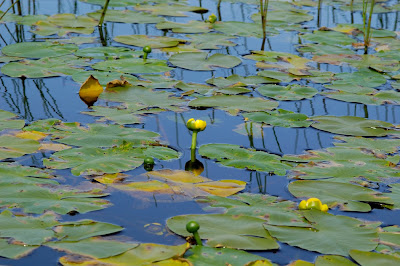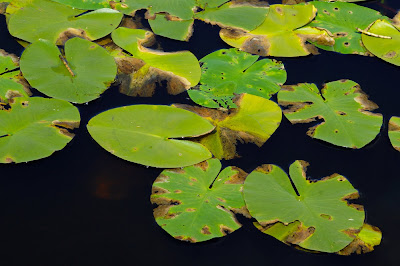With the intention of looking for basking adders, I walked from Duntocher to the Humphrey, past the Lily Loch and over to Burncrooks reservoir, past the Kilmannan reservoir and then back home (via the Humphrey again).
 |
Yellow Shell Moth (Camptogramma bilineata)
|
Hogweed (Heracleum sphondylium) was flowering all along Beeches Road, the white, flat-topped umbels atrracting a multitude of insects.
At first glance, umbellifer species seem indistinguishable but with a bit of practice they are easy to tell apart - the key identifying features of Hogweed are its large size & sturdiness, the petals of the outer flowers are larger, unequal and deeply notched, and the leaves are broad-lobed and slightly hairy.
Hogweed contains furanocoumarins: these have phototoxic properties (cause damage to the skin when exposed to light). Despite this, the young stems and roots are said to be edible when cooked (celery also contains furanocoumarins) - but maybe not in large quantities...
At first glance, umbellifer species seem indistinguishable but with a bit of practice they are easy to tell apart - the key identifying features of Hogweed are its large size & sturdiness, the petals of the outer flowers are larger, unequal and deeply notched, and the leaves are broad-lobed and slightly hairy.
Hogweed contains furanocoumarins: these have phototoxic properties (cause damage to the skin when exposed to light). Despite this, the young stems and roots are said to be edible when cooked (celery also contains furanocoumarins) - but maybe not in large quantities...
 |
| Hogweed (Heracleum sphondylium) |
 |
| Meadowsweet (Filipendula ulmaria) |
Meadowsweet (Filipendula ulmaria) has a sweetly scented, creamy-popcorn-coloured froth of flowers which can be dried for use in herbal teas or made into a syrup for flavouring drinks/deserts. The leaves are also aromatic and can be used to flavour soups or dried for herbal tea.
Meadowsweet contains salicylaldehyde which can oxidise to form salicylic acid (similar to the active component of aspirin) which is a mild painkiller. For this reason, and also for its antiseptic properties, meadowsweet has been used for centuries to treat mouth ulcers, acne, heartburn and peptic ulcers, amongst other ailments.
Meadowsweet recipes (tempting eh?)
Meadowsweet & vanilla panna cotta: http://www.eatweeds.co.uk/meadowsweet-vanilla-panna-cotta
Meadowsweet sorbet: http://www.eatweeds.co.uk/meadowsweet-sorbet-recipe
Approaching the Humphrey, I passed a field full of young Aberdeen Angus bulls - of which I was terrified. They were very excited when they saw me (presumably expecting to be fed) and began aglloping about and following me along the fence. I could not shake off the fear that the fence might peter out at some point...
At the Humphrey there were plenty of Common Blue Damselflies (Enallagma cyathigerum), delicately perched on reeds or basking on the stony path. I walked towards the pond next to the Humphrey but had to retrace my steps carefully as the ground was thronging with hundreds of tiny toadlets. Surely some of these are the offspring of the toads that my dad and I rescued this spring? I like to think so :)
Meadowsweet contains salicylaldehyde which can oxidise to form salicylic acid (similar to the active component of aspirin) which is a mild painkiller. For this reason, and also for its antiseptic properties, meadowsweet has been used for centuries to treat mouth ulcers, acne, heartburn and peptic ulcers, amongst other ailments.
Meadowsweet recipes (tempting eh?)
Meadowsweet & vanilla panna cotta: http://www.eatweeds.co.uk/meadowsweet-vanilla-panna-cotta
Meadowsweet sorbet: http://www.eatweeds.co.uk/meadowsweet-sorbet-recipe
Approaching the Humphrey, I passed a field full of young Aberdeen Angus bulls - of which I was terrified. They were very excited when they saw me (presumably expecting to be fed) and began aglloping about and following me along the fence. I could not shake off the fear that the fence might peter out at some point...
At the Humphrey there were plenty of Common Blue Damselflies (Enallagma cyathigerum), delicately perched on reeds or basking on the stony path. I walked towards the pond next to the Humphrey but had to retrace my steps carefully as the ground was thronging with hundreds of tiny toadlets. Surely some of these are the offspring of the toads that my dad and I rescued this spring? I like to think so :)
 |
| Toad (Bufo bufo) |
 |
| The Lily Loch |
The dark peaty waters of the Lily Loch were afloat with lily pads and the air was buzzing with dragonflies, damselflies and clegs.
As I sat on the banks of the Lily Loch I could hear the yickering/laughing calls of the pair of Little Grebes (Tachybaptus ruficollis) which have nested here this year. They were very secretive, hiding in the vegetation at the opposite side from me.
The lily pads belong to the Yellow Water Lily (Nuphar lutea):
As I sat on the banks of the Lily Loch I could hear the yickering/laughing calls of the pair of Little Grebes (Tachybaptus ruficollis) which have nested here this year. They were very secretive, hiding in the vegetation at the opposite side from me.
The lily pads belong to the Yellow Water Lily (Nuphar lutea):
 |
| Yellow Water Lily (Nuphar lutea) |
 |
| Yellow Water Lily (Nuphar lutea) |
Species of dragonfly/damselfly I spotted at this site were: Large Red Damselfly, Common Blue Damselfly (of which there were many), Blue-tailed Damselfly, Four-Spotted Chaser (also very numerous) and an Aeshna species (I was unable to get close enough for a proper identification).
3.jpg) |
| Common Blue Damselfly (Enallagma cyathigerum) male |
The Clegs (Haematopota pluvialis) were driving me mad at the Lily Loch - extra strong DEET doesn't deter them, you actually have to physically beat them off! I followed the burn that feeds into Burncrooks reservoir - New Zealand Willowherb (Epilobium brunnescens), an introduced species, grows on the rocks here.
On Burncrooks reservoir there was a family of Canada Geese (Branta canadensis), a few Greylag Geese (Anser anser), and a lone Linnet (Carduelis cannabina) darting about on the rocky banks.
The ledge above the dam was brightly coloured with White Clover(Trifolium repens), Red Clover (Trifolium pratense), Lesser Trefoil (Trifolium dubium) and Slender St. John's Wort (Hypericum pulchrum). The buds of Slender St. John's Wort are vibrantly scarlet-dipped.
On Burncrooks reservoir there was a family of Canada Geese (Branta canadensis), a few Greylag Geese (Anser anser), and a lone Linnet (Carduelis cannabina) darting about on the rocky banks.
The ledge above the dam was brightly coloured with White Clover(Trifolium repens), Red Clover (Trifolium pratense), Lesser Trefoil (Trifolium dubium) and Slender St. John's Wort (Hypericum pulchrum). The buds of Slender St. John's Wort are vibrantly scarlet-dipped.
 |
| Slender St. John's Wort (Hypericum pulchrum) |
 |
| Red Clover (Trifolium pratense) |
 |
| White Clover (Trifolium repens) |
There were plenty of large Gold-ringed Dragonflies (Cordulegaster boltonii) zooming around Burncrooks and I managed to creep up on this handsome male, as he rested in the heather.
.jpg) |
| Gold-ringed Dragonfly (Cordulegaster boltonii) male |
5.jpg) |
| Gold-ringed Dragonfly (Cordulegaster boltonii) male |
4.jpg) |
| Gold-ringed Dragonfly (Cordulegaster boltonii) male |
This magnificent insect is about 7-8cm in length and is the only yellow and black dragonfly found in Scotland. Its scientific name means 'Bolton's clubbed-belly' (Cordule, from Greek kordylinus = clubbed, gaster = belly).
After this encounter, it was time to walk homewards. I followed the path through the coniferous plantation on the Eastern side of Burncrooks reservoir. At the side of this path there is a collection of gravelly ponds (flooded quarry) where I have seen Emerald Damselflies (Lestes sponsa) in the past. I decided to search these ponds another day as there were lots of forestry commission vehicles parked around this area and warning signs have recently been put up to keep people away (I'll go back when it's quieter!). I had a brief glimpse of a flock of Jays (Garrulus glandarius) as I walked through the plantation.
There's a major tree-felling operation going on around the Kilmannan reservoir and I went to investigate the cleared land - it currently looks a bit post-apocalyptic: churned up earth, deep trenches, bits of tree/logs/stumps strewn everywhere. If I was a kid I'd probably have the time of my life playing amidst this destruction, heh! Some of the ditches had formed algae-ed ponds already - a new habitat in the process of creation.
Traversing this ravaged landscape I came across a young Dunnock (Prunella modularis) perched on a felled tree.
 |
| Dunnock (Prunella modularis) immature |
.jpg) |
| Dunnock (Prunella modularis) immature |
.jpg) |
| Dunnock (Prunella modularis) immature |
Dunnocks are strange little birds - they are always creeping about, rodent-like in the undergrowth, but quite often they'll come right up to you and seem almost tame.
Although drab and inconspicuously-plumaged, Dunnocks have a relatively unusual breeding system. Dunnocks are commonly polyandrous (2 or 3 males mate with and care for the offspring of 1 female), polygynous (1 male and 2 females) and polygynandrous (2 or 3 males with 2 - 4 females). Of course, they may also be monogamous (forming a pair: 1 male and 1 female) - the typical system in most birds.

 |
| The River Clyde |





No comments:
Post a Comment